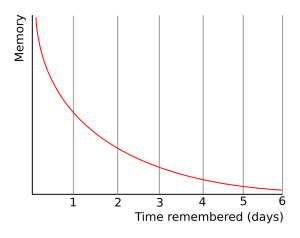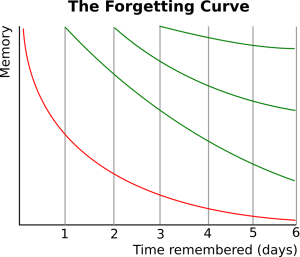A student asked me this week if it’s better to have frequent short practice sessions or less frequent longer sessions. My answer is always that regular sessions, ideally every day but at least 5 days a week, are more beneficial due to the phenomenon known as the ‘forgetting curve’.
We all know that you don’t remember every single event that happens in your life, or every individual piece of information you acquire. Your brain is ruthlessly efficient at clearing out anything it doesn’t have a good reason to store long term – to the best of our knowledge there is not a maximum amount of information that can be stored by the brain, but it doesn’t want random shopping lists from 20 years ago cluttering up the place. The result is that if information is not regularly reinforced it will be dispensed with after some amount of time.

However, if we see this information again, it will be revived and stored again. One repetition is not enough to secure a coveted spot in long term memory, but further repetitions over time will reinforce the importance of that information until it is almost impossible for it to leave entirely (barring some form of brain injury or disorder such as dementia).

Now we’ve established the benefits of frequent practice sessions, how much time is needed? When I started learning my first instrument I was told 30 minutes a day. I have no idea why, or who decided that was the perfect amount (spoiler alert: it isn’t) but that’s what I was told so I did it (…mostly). The main problem with this approach was clock-watching, encouraging me to dawdle on certain tasks or mindlessly playing through pieces until the magic number was reached and I could put my violin away for the day. This meant I often didn’t get as much out of my practice sessions as I could have, because I was more concerned with meeting an arbitrary target than what I was actually playing.
Practice sessions, or at least the combined amount of practice per day, does require some attention to duration – you won’t achieve much if you only practice for 1 minute per day. Beginners playing short pieces from their method books can get by with as little as 10-15 minutes a day, and younger children may need to play for only a few minutes at a time, because their attention span is short and they cannot maintain focus on one task for very long. As the pieces get longer and more complex the amount of time needed to cover them in a timely manner will increase, and by the time a student gets to Grade 8 (averaging around 8-10 years of learning) they should be doing at least an hour a day. Beyond that point it’s as much time as you can fit in – post-secondary students and professionals will likely be doing focused practice for 4+ hours a day, and if you’re really dedicated you might find a way to bend the passage of time so you can practice 40 hours a day.
The key word here is ‘focused’ – decide on a goal for that practice session and a particular area to work on, rather than just bashing through the piece from start to finish over and over again and hoping it somehow magically falls into place. Playing pieces all the way through should be a part of your practice schedule but the majority of the time should be based around small sections which are causing difficulties for you, not giving an equal amount of attention to the easier parts of the piece.
The overall answer is that little and often beats long and infrequent every time, and while you should have a rough idea of timing in your head it’s better to think about the purpose of each practice session rather than grinding to hit a magic number. Remember that the purpose of practice is to make progress in your musical journey, and while it’s not always easy it’s always worthwhile.
0 Comments